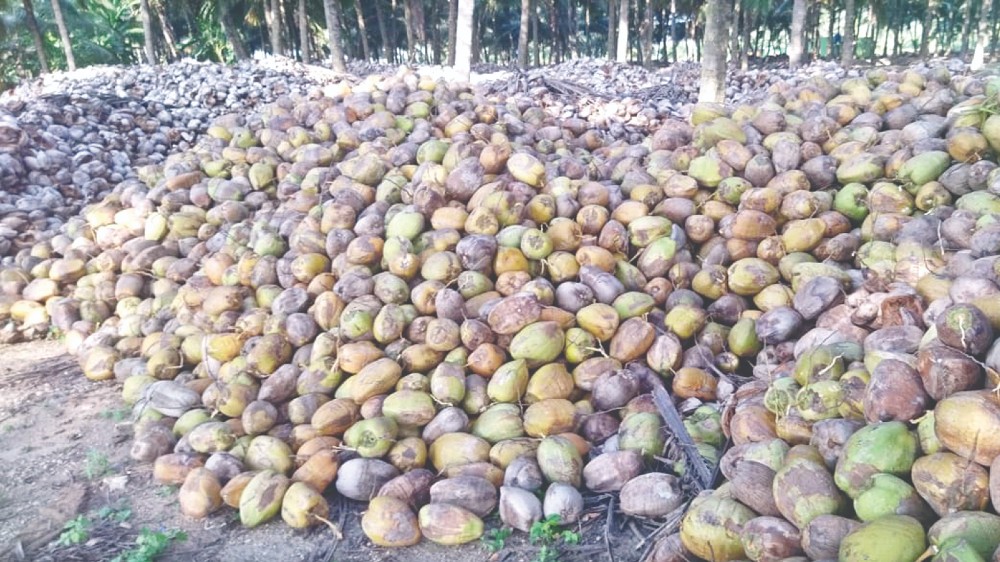Sabarimala season perks up coconut price
Farmers are hoping for both the price and demand for coconuts to surge further in the coming days due to declining production.

COIMBATORE: A spurt in demand for coconuts from Pollachi, a major producer in Tamil Nadu, with the start of the Sabarimala season has given some reasons to cheer for farmers.
A sharp increase in demand has led to coconut prices, which was ruling at a record low, to go up marginally. “Demand for coconuts, taken by pilgrims visiting Sabarimala temple in Kerala from different states has shot up considerably. In fact the price rise has come at a time, when coconut production has almost stopped in Kerala and reduced drastically in both Tamil Nadu and Karnataka with the onset of winter,” said N Thangavel, member of Tamil Nadu Coconut Producers Association.
Within the last three weeks, the farm gate price of coconuts (with green fibre) has increased from Rs 24,000 to Rs 27,000 per tonne and dried ones from Rs 25,000 per tonne to Rs 30,000.
As expected, the crushing copra prices have also shot up from Rs 73 per kg last month to Rs 90 now due to a dip in its production. Similarly, coconut oil prices rose from Rs 1,740 (15 kg tin) to Rs 1,900.
Farmers are hoping for both the price and demand for coconuts to surge further in the coming days due to declining production. They still lament that even this price rise does not fetch enough profits. Despite Covid pandemic, the farm gate price of coconuts hovered above Rs 22 per nut around this time last year. It however nosedived to lowest ever a few weeks ago to Rs 8.50 and rose to Rs 13 following an uptick in demand due to the ongoing pilgrim’s season.
A Thangavel alias Periappan, a farmer from Anaimalai said that prices of coconuts have risen by just 10 per cent due to the ongoing demand. “Devotees invariably prefer raw coconuts that are smaller in size as it would be easier for them to carry during the pilgrimage. Such coconuts come from Krishnagiri and Dharmapuri districts as against Pollachi nuts that weigh more than 500 grams, almost double the size of coconuts from other regions,” he said.
Even as the domestic market is gradually picking up, the coconut export market continues to be in doldrums due to acute shortage of containers. Farmers claimed that until a few years ago, coconut producers used to send up to five containers of 40 feet per week and each with a holding capacity of upto 55,000 coconuts to gulf nations. But now, the exports have dropped to meager four or five containers for the whole month.
“Shipment of a 20 feet container to Dubai, which normally costs Rs 80,000 a few months ago, has skyrocketed to around Rs 2.5 lakh. Container shortage has completely hit exports. Coconuts were mainly sent to gulf countries, London and Mauritius,” said an exporter.
Cultivation area doubles as many switch from other crops to coconut farming
In a significant change in the farming landscape, most farmers have switched over to coconut cultivation from other crops across Tamil Nadu.
A foremost reason attributed for turning to coconut cultivation, considered a safe bet, is the acute shortage of labour.
“Labour shortage is forcing farmers to go for coconut trees, which require minimum workforce as compared to paddy or other short term crops. Earlier, coconut used to be lined up only in areas along the water bodies, but now farms have come up widespread with supply of water through drip irrigation,” said Dhanabal Muthusamy, Director of Anaimalai Coconut Producers Company.
The issue of labour shortage began to crop up over the last 10 years after workers began to shun farm work and opted to go for the 100 days employment scheme under Mahatma Gandhi National Rural Employment Guarantee Scheme.

“Rather than sweating it out in farms, workers look to make some quick bucks by going to work under the job guarantee scheme. It has come as a major blow to the farming sector. Even though farmers are ready to go for cultivating other crops, they are left with no choice due to lack of labour,” said N Thangavel, member of Tamil Nadu Coconut Producers Association.
It’s no surprise that the area of coconut cultivation has also witnessed a significant spurt from 2.5 lakh hectares before 10 years ago to over five lakh hectares now in Tamil Nadu.
“Significantly, a majority of farmers in both Coimbatore and Tirupur districts have moved over to coconut cultivation. Until a decade ago, only 50 per cent of farmers were into coconut cultivation, which involves less labour,” said Dhanabal Muthusamy.
For instance, almost 60 per cent of area in Anaimalai near Pollachi has entirely come under coconut cultivation. “Even farmers who were cultivating paddy have switched over to coconut. Only in areas, where coconut could not be cultivated due to adverse reasons, paddy is harvested,” said farmers.
Visit news.dtnext.in to explore our interactive epaper!
Download the DT Next app for more exciting features!
Click here for iOS
Click here for Android



